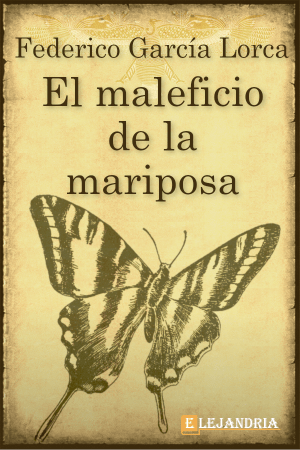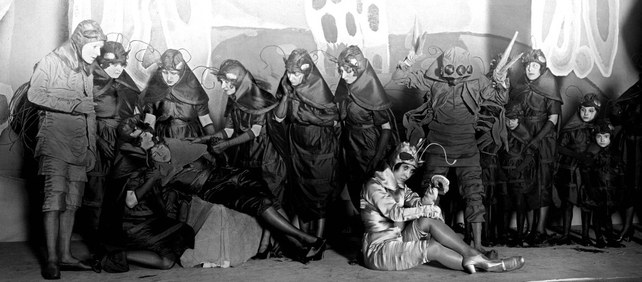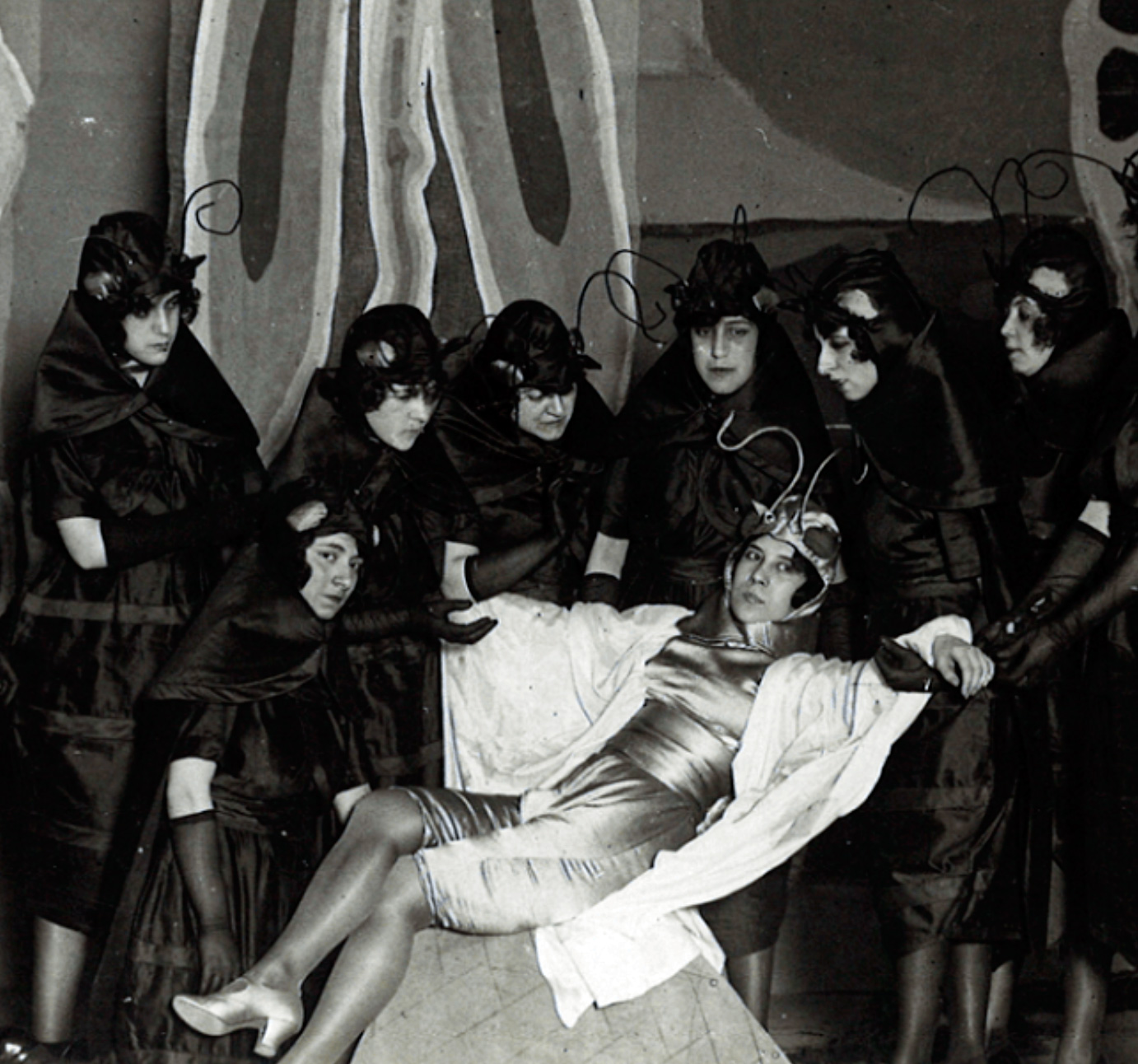
El maleficio de la mariposa (The Butterfly’s Evil Spell) was the first theatrical work premiered by Federico García Lorca, then a 21-year-old boy who arrived in Madrid in 1919 from his native Granada. It is a fable written from a lost poem that was to be part of the Book of Poems. The artistic result of the performance was a resounding failure.
The comedy, divided into two acts and a prolog, stars characters representing insects such as Mrs. Cockroach, Witchcockroach, Sylvia Cockroach, Boycockroach, several worms numbered from one to three, the Alacrancito Scorpy and the Butterfly.
The first act, composed of six scenes, takes place in a meadow “green and humble under the dense shade of a large cypress” at the “chaste hour of dawn”. The second consists of seven scenes and takes place in a garden “with a great cascade of ivy” and “the whole area covered with giant daisies”.
The manuscript was lost for many years and when it appeared it was incomplete: the last pages were missing, which meant that the outcome had to be assumed. Francisco García Lorca adventure that ends with the suicide of the protagonist, an assumption that seems to be deduced also from the comments that appeared in the press after the premiere (“The illusion is truncated and the existence of the audacious dreamer too”) and from the prolog itself: “There is no use telling you that the enamored little bug died, because Death is disguised as Love!”.
The fable takes place in a community of cockroaches (curianas in Lorca’s language) where several insects of different character and sensibility live together. One of them, Boycockroach, suffers the scorn of the other members of the group because of his vocation for poetry. A snub shared by his mother, Mrs. Cockroach, and his suitor, Cockroach Sylvia, whom he treats with disdain. One day, however, a dying butterfly with a broken wing lands in the community. This unexpected arrival causes a great commotion. Boycockroach will end up falling in love with the new tenant, who, however, will not be able to reciprocate due to her poor condition. Once she has recovered, and at the moment when Boycockroach declares his love, the Butterfly begins a dance that drained her of her strength and lead to her death. Boycockroach embraces the Butterfly: “Tienes el cuerpo frío [Your body is cold]. Ven conmigo [Come with me], / que es mi cueva templada [which is my warm cave] / y desde allí verás el prado verde [and from there you will see the green meadow] / perderse en la distancia [fade away in the distance]”.
The supposed candor of the plot contains deep symbolic references. According to Ian Gibson, the thesis of the play is that love is a purely fortuitous phenomenon. In his opinion, young Lorca projected in The Butterfly’s Evil Spell “his erotic desires, his fears and his metaphysical doubts on the desperate Boycockroach, since the orthopteran’s complaints repeat, almost word for word” similar ones that appear in the poems Minor Song and Alba. “The Buttefly’s Evil Spell is a thinly disguised excuse for erotic expression, and it is striking that, for his mistress, he has chosen an insect considered repugnant,” he concludes.
García Lorca’s first dramatic work premiered at the Eslava Theater in Madrid on March 22, 1920, and only withstood four performances (or two according to other sources) due to the vehement rejection by the audience who tore it apart. At the theater door, according to José Mora Guarnido, there were even exchanges of blows between the detractors and the friends that Federico had recruited among the rinconcillistas who lived in Madrid and the companions of the Residencia de Estudiantes. The play was part of the Teatro del Arte program promoted at the Eslava by Gregorio Martínez Sierra and his wife María de la O Lejárraga.
The comedy, by the playwright Martínez Sierra, was performed by the actress Catalina Bárcena, in the role of Curianito El Nene, while the Butterfly was played by a young woman Encarnación López Júlvez, La Argentinita, with whom Federico had a close personal and artistic relationship until her death in 1936. The sets were designed by the Uruguayan set designer Rafael Pérez Barradas. However, Gregorio Martínez Sierra believed them to be too daring and commissioned them to film and theater director Fernando Mignoni Monticelli. Barradas, however, designed the costumes. The music chosen was incidental pieces by Norwegian composer Edward Grieg instrumentalized by José Luis Lloret.
The comedy, finished by Lorca in a hurry at the request of Martínez Sierra, was initially entitled the playwright Infamous comedy and then The star of the meadow, names that Martínez Sierra rejected. According to Mora Guarnido, it was the producer himself who gave it the final title on his own, due to Lorca’s doubts and the proximity of the premiere.
Perhaps because the original piece that is preserved is incomplete, this one was excluded from the first Complete Works and then added, but not in the volume of dramatic work but in another complementary Work disclosed. In 2020, a new edition prepared by Víctor Fernández appeared in the Debolsillo publishing house.
The topic comes from one of the poems that Lorca composed during the summers in the house in Valderrubio and that make up his initial Libro de poemas (Book of Poems), edited later, in 1921. The young Lorca felt a predilection for poems of a pantheistic tone starring animals under the direct influence of Rubén Darío (see the poem Los motivos del Lobo (The Wolf Motives)). Many of those little fables were excluded from the final selection, although some survived thanks to the efforts of Mora Guarnido and the editor Gabriel García Maroto, such as Los encuentros de un caracol aventurero (The Encounters of an Adventurous Snail). Among the discarded and lost poems was one that referred to the “minimal adventure” of a butterfly with a broken wing that falls into a nest of cockroaches. The cockroaches take her in and heal her. When she recovers her strength, she makes a pirouette in the air and leaves the son of a cockroach, who had fallen madly in love with her, desolate. Federico used to graciously recite those poems that later, in print, lost part of their charm.
In a letter addressed to his family in the Acera del Casino, written in the days prior to the premiere of El maleficio de la mariposa (The Butterfly’s Evil Spell), Federico gives an account of the process of mounting the play and refers to the first reading of the complete manuscript: “The day before yesterday was the final reading before the entire company and a somewhat increased number of young mediocre writers who had entered because they knew me. I do not need to tell you that I do not care about the success of the work before the public because the triumph I had before the company is the strongest success I have had in my short literary life. La Argentinita, who is indeed a very nice and smart girl, gave herself an upset stomach from crying and in the last act almost all the girls and some young men had tears in their eyes”.
The El Rinconcillo members and the friends of the Residencia de Estudiantes, expressly invited by Lorca and spread throughout the Eslava Theater before the predictable failure, tried to mitigate the booing with applause and shouts of encouragement. At the end of the performance they went with the author to celebrate the premiere at the Granja del Henar café where cups of chocolate sweetened the bitter experience.
Gregorio Martínez Sierra, who had close ties to Granada, learned of the poem from Federico himself and did not hesitate to commission him to dramatize it, even though Lorca lacked experience as a playwright. The job ahead of him was almost impossible: to turn two pages of verse into a two-act, hour-long performance; to stretch the scant action into a solid plot; to underline the dramatic conflict so that it would be plausible; and to use verse with due dramatic effectiveness. As the date of the premiere approached, doubts multiplied. Federico thought of withdrawing the play and asking his father for a loan to compensate Martínez Sierra. In the end he decided to summon the “rinconcillistas” living in Madrid to adopt a common solution. The conclave was attended by Juan de Dios Egea, Melchor Fernández Almagro, José Fernández-Montesinos, Manuel Ángeles Ortiz and José Mora Guarnido. Although there were all kinds of different opinions, in the end Mora’s position prevailed: Even if the play failed, it would not erase “the consecrating hierarchy of the author in a theater as important as the Eslava”. Of course, in case it was torn apart, he had to face it with humor and in no case assume it as a defeat.

Barradas’ costumes did not exactly help to mitigate the effect of the play’s dialogues that provoked hilarity among the Eslava Theater audience. Catalina Bárcena, the Señora Cucaracha (Mrs. Cockroach), appeared on stage with her legs girded by a black leotard, a patent leather chapstick, with a round helmet on her head with two little twisted feathers on the sides. When it was her turn to exclaim “but what do I have on my head?”, a joker from the audience answered: “Two little horns”. La Argentinita’s characterization as a Butterfly did not help to save the show either.
Francisco García Lorca recalls that on the day of the premiere he was in Granada with his family waiting for news. Federico’s father had asked a financial friend of his who lived in Madrid to telegraph him as soon as the performance was over. “My parents, my sisters and I were gathered in the dining room of the house […]. In the end, it was already after one o’clock when the telegram was received. Don Manuel Conde, which was the friend’s name, had written it piously, but it expressed more truth than he believed deep down. It read as follows: “The audience didn’t like the play. Everyone agrees that Federico is a great poet”.
Critics were more or less supportive of the new author. The critic Don Pablos, in El Heraldo, wrote: “We applaud the poetic work of Mr. García Lorca. We censure only the environment in which the little play is staged”. Andrenio, in La Época, is conclusive: “It must be confessed that the play has been a failure. The public’s protest was rude and cruel at times”.
Staging of Federico García Lorca’s play ‘The butterfly’s evil spell’ jointly by the Alcalá groups TELA and Maru-JASP, whose premiere took place on January 11, 2004 at the Margarita Xirgu theater in Alcalá de Henares (Madrid).

